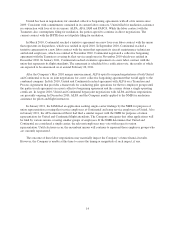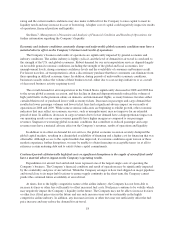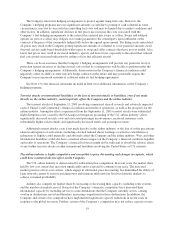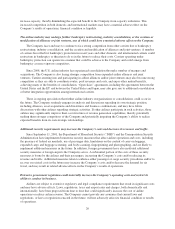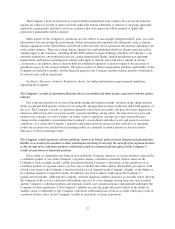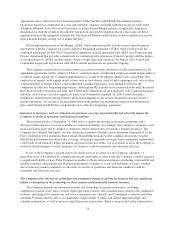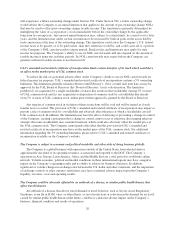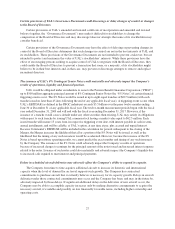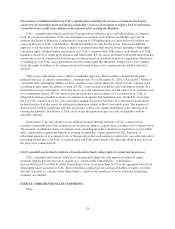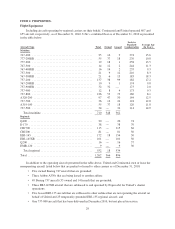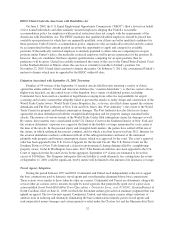United Airlines 2010 Annual Report Download - page 24
Download and view the complete annual report
Please find page 24 of the 2010 United Airlines annual report below. You can navigate through the pages in the report by either clicking on the pages listed below, or by using the keyword search tool below to find specific information within the annual report.The Company’s plans to enter into or expand antitrust immunized joint ventures for various international
regions are subject to receipt of approvals from applicable federal authorities or otherwise satisfying applicable
regulatory requirements, and there can be no assurance that such approvals will be granted or applicable
regulatory requirements will be satisfied.
Many aspects of the Company’s operations are also subject to increasingly stringent federal, state, local and
international laws protecting the environment. Future environmental regulatory developments, such as climate
change regulations in the United States and abroad could adversely affect operations and increase operating costs
in the airline industry. There are certain climate change laws and regulations that have already gone into effect
and that apply to the Company, including the EU ETS (subject to legal challenge), the State of California’s cap
and trade regulations, environmental taxes for certain international flights, limited greenhouse gas reporting
requirements and land-use planning laws which could apply to airports and could affect airlines in certain
circumstances. In addition, there is the potential for additional regulatory actions in regard to the emission of
greenhouse gases by the aviation industry. The precise nature of future requirements and their applicability to the
Company are difficult to predict, but the financial impact to the Company and the aviation industry would likely
be adverse and could be significant.
See Item 1, Business—Industry Regulation, above, for further information on government regulation
impacting the Company.
The Company’s results of operations fluctuate due to seasonality and other factors associated with the airline
industry.
Due to greater demand for air travel during the spring and summer months, revenues in the airline industry
in the second and third quarters of the year are generally stronger than revenues in the first and fourth quarters of
the year. The Company’s results of operations generally reflect this seasonality, but have also been impacted by
numerous other factors that are not necessarily seasonal including, among others, the imposition of excise and
similar taxes, extreme or severe weather, air traffic control congestion, geological events, natural disasters,
changes in the competitive environment due to industry consolidation and other factors and general economic
conditions. As a result, the Company’s quarterly operating results are not necessarily indicative of operating
results for an entire year and historical operating results in a quarterly or annual period are not necessarily
indicative of future operating results.
The Company could experience adverse publicity, harm to its brand, reduced travel demand and potential tort
liability as a result of an accident or other catastrophe involving its aircraft, the aircraft of its regional carriers
or the aircraft of its codeshare partners, which may result in a material adverse effect on the Company’s
results of operations or financial position.
An accident or catastrophe involving an aircraft that the Company operates, or an aircraft that is operated by
a codeshare partner or one of the Company’s regional carriers, could have a material adverse effect on the
Company if such accident created a public perception that the Company’s operations, or the operations of its
codeshare partners or regional carriers, are less safe or reliable than other airlines. Such public perception could
in turn cause harm to the Company’s brand and reduce travel demand on the Company’s flights, or the flights or
its codeshare partners or regional carriers. In addition, any such accident could expose the Company to
significant tort liability. Although the Company currently maintains liability insurance in amounts and of the type
the Company believes to be consistent with industry practice to cover damages arising from any such accident,
and the Company’s codeshare partners and regional carriers carry similar insurance and generally indemnify the
Company for their operations, if the Company’s liability exceeds the applicable policy limits or the ability of
another carrier to indemnify it, the Company could incur substantial losses from an accident which may result in
a material adverse effect on the Company’s results of operations or financial position.
22




